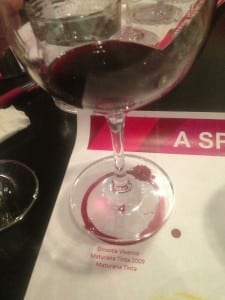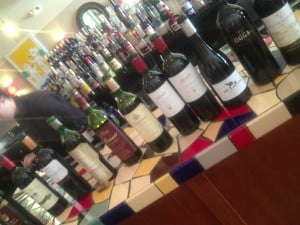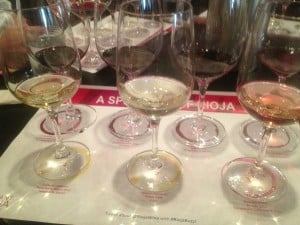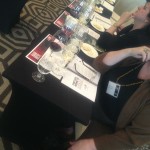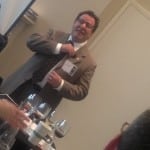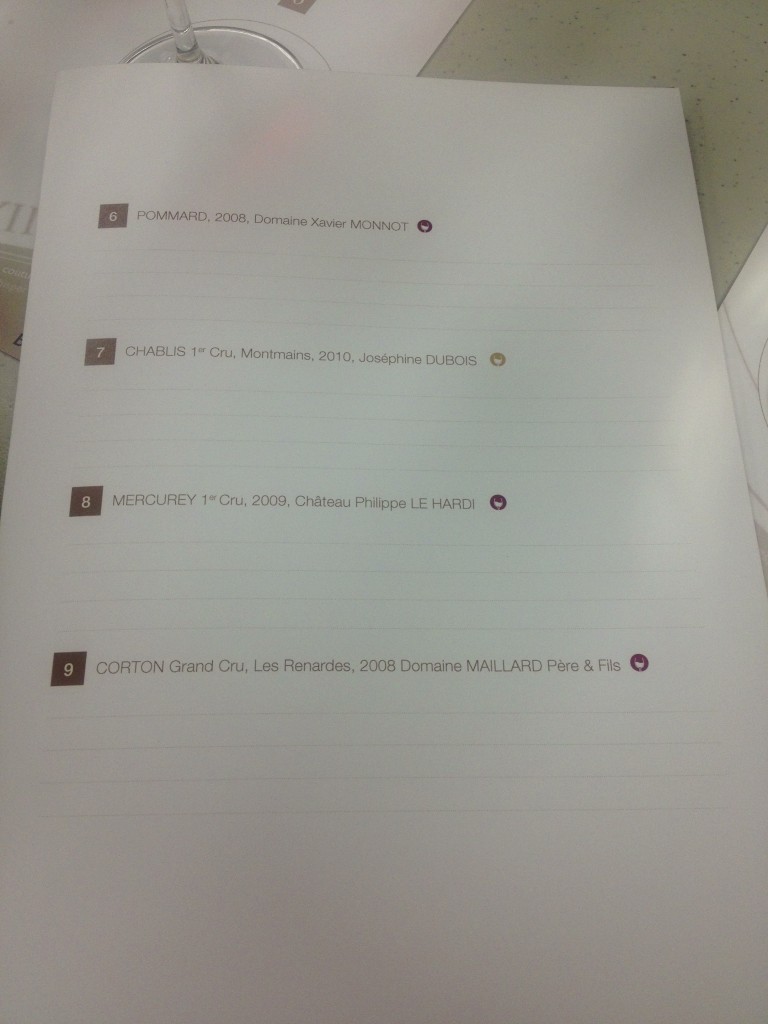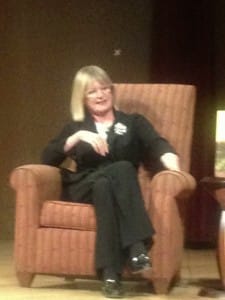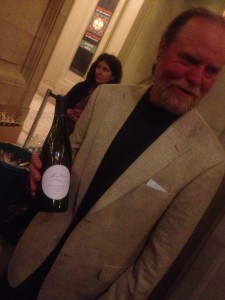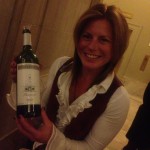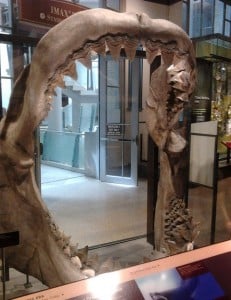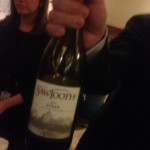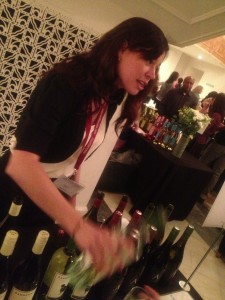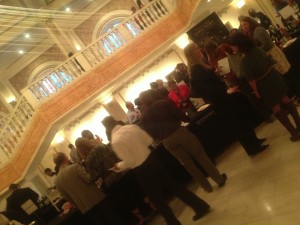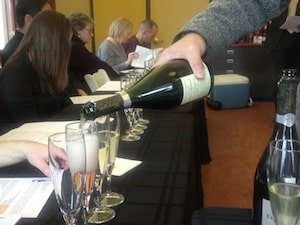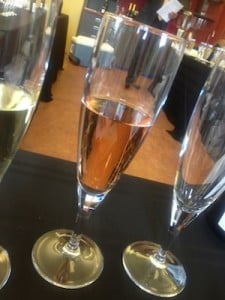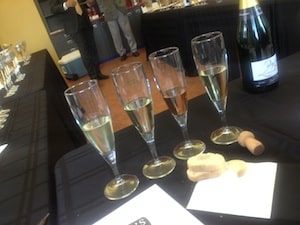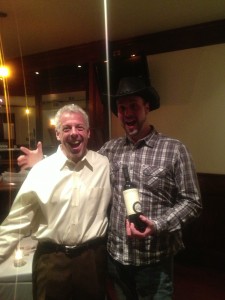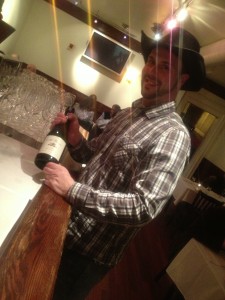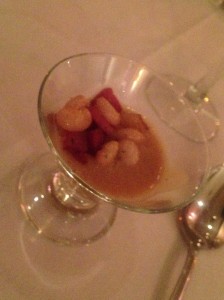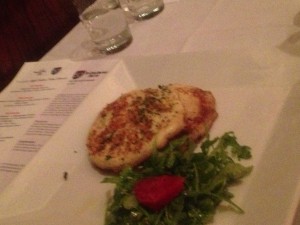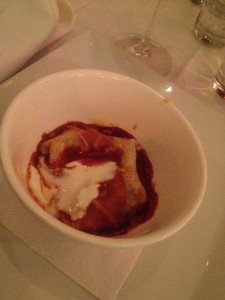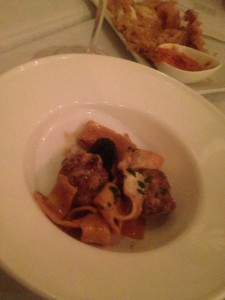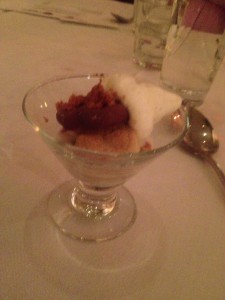Posts Tagged ‘dc wine scene’
Georgian Wine Tasting – Saperavi, Rkatsiteli & More!
Saperavi — Mtsvane (silent “M”) — Rkatsiteli (silent “R”) – Georgian wines came to Washington, D.C. for a fantastic Trade Tasting held at Vidalia Restaurant on Monday, October 19, 2015 and really made a show! Presented by Georgian Wines (Facebook Event Here) the tasting was sponsored by The National Wine Agency, a division of the Ministry of Agriculture of the Republic of Georgia.
So what makes Georgian wine unique?
1)Wines are made in an ancient traditional way – the “qvevri” which according to Wikipedia: “large earthenware vessels used for the fermentation, storage and ageing of traditional Georgian wine”.
2)Orange or amber wines are created for white wine varietals due to skin contact while fermenting and aging. According to Wine Enthusiast: “Orange wines are white wines produced more like reds, with prolonged maceration of crushed grape skins and seeds.” Article Link Here . The taste is quite unique from this maceration and storing in clay pots – dried fruits like apricots and floral notes immediately come to mind, but of course it depends on the quality of grapes and the varietal. We tasted many Rkatsitelis (“R” is silent – so “cats-e-telee”) and Mtsvanis (“M” is silent – so “svah-nee”) and one in particular that was memorable was the Shalauri Mtsvane that was decanted – see image – “dried apricots, floral aromas and tea-like in flavor” – Very, VERY dry wines as well – not even a hint of residual sugar on my palate and medium acidity – these wines CRY for food! Mamuka Tsereteli, the infamous importer/distributor of many Georgian wines for Georgian Wine House in the Mid-Atlantic Region also told me I needed to taste his Our Wine Rkatsitelli – this “amber wine” (which seemed to be a more favorable expression at the event – I guess my love of Orange Fanta didn’t go over well!!) had an intensity/acidity and dried fruit/tea/smoked ham (I stole this descriptor from the pamphlet..but overall, it’s a goodie!) aroma/flavor profile that really stood out at the event!
3)Over 500 “unique/indigenous” varietals with 8,000 years of winemaking history – literally, the cradle of winemaking as we know it! Here are some I tasted: Chinebuli, Tsitska, Mtsvane, Saperavi, Tsolikouri, Rkatsiteli, Ojaleshi, Otskhanuri Sapere, Kisi and Krakhuna..400+ to go..
THE LIST OF PARTICIPATING PRODUCERS INCLUDES:
Amiran Vepkhvadze
Antadze
Bagrationi
Chateau Mukhrani
Gotsa
Iago’s Wine
Jakeli
Kindzmarauli Marani
Lagvinari
Marani (Telavi Wine Cellars)
Orgo
Our Wine
Pheasant’s Tears
Sarajishvili
Schuchmann
Shaluri
Shalvino
Shavnabada Monastery
Shumi
Teliani Valley Winery
Vinoterra
WineMan
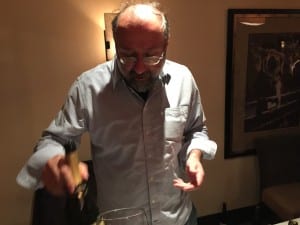
Mamuka Tsereteli – the Legend of Georgian Wines!
My Attempt at Tasting 250 New Wines – Wines of Portugal Tasting
Portugal is Unique in that they produce 250 grape varietals unique to their region..
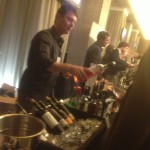
OK, I didn’t actually try to taste 250 new grape varietals (can you say “Alvarinho”, “Baga” “Trincadeira” or “Touriga Nacional” ?) but I did try to better understand the wonderful variety of wines coming from a country with a unique language and known more for fortified wines – their Ports – than for their still wines.
The best part of my tasting was the seated seminar with Evan Goldstein
– I had seen him in videos, but it was great to actually meet the wine powerhouse in person. Passionate is not a wasted word on this wine lover – he really presented with energy and humor and a keen sense of fun and adventure – he popped a few key Portguese words into the presentation but for the obvious effect – few people understand the language!
So what did I learn from the seated tasting of 7 wines (it was supposed to be 8, but one never made it through shipping!) ?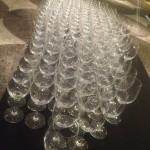
-Vinho Verde which translates as “Green Wine” does NOT mean green-hued wine, but rather a wine meant to be consumed “young”.
-Portuguese “Verdelho” is NOT the same as Spanish “Verdejo”
-There is a Rose Vinho Verde
-There are many micro-climates and the wines from the southern planes tend to ripen very evenly from year to year.
-Moscatel de Setubal is a Muscat Fortified wine other than Port from the southern Peninsula and has more of a golden raisin/apricot flavor than Ports more prunish, dark fruit flavors.
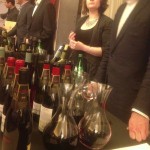 Overall I was impressed by the consistency of the wines – most had abundent acidity and enough fruit and flavor for backbone. Some of the reds such as the pure Touriga Nacional’s were quite tannic and “cedar box” spice, but still the average quality of wines was quite good.
Overall I was impressed by the consistency of the wines – most had abundent acidity and enough fruit and flavor for backbone. Some of the reds such as the pure Touriga Nacional’s were quite tannic and “cedar box” spice, but still the average quality of wines was quite good.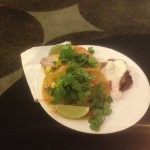
I do want to mention that TasteDC was affiliated with the Consumer Grand Tasting that evening and helped to sell it out – although the wines were the same in the consumer tasting, the food was much better than the Trade got which is actually a good thing. Also the food was quite good – really tender carved Roast Beef, Ham Table, Specialty Taco Table and something I hadn’t seen before – a Ramen Noodle table with the chance to choose your own noodles and fixings- this kept the Vegetarians happy – Cheers!
Charlie “I Drink on the Job” Adler
Only the Vines Must Suffer – Burgundy Tasting in DC at Capital Wine School
“In Order to Make Great Wine, the Vines Must Suffer..”
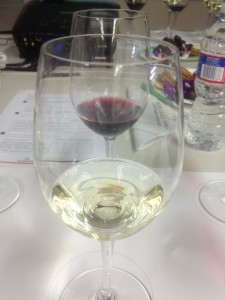
I attended a recent trade tasting given by the Bureau of Burgundy Wines on Tuesday, April 23rd at the Capital Wine School in Washington, D.C. – it was taught by a very affable and precise Jean-Pierre Renard who took us through history, philosophy and ultimately a tasting of 9 wines from the lowest classification up to a Grand Cru – Corton Grand Cru, les Renardes, 2008 Domaine Maillard.
We covered the basics of Burgundy which can actually be quite confusing. In a nutshell, Burgundy is a region and the wines are named from their location in that region. The basic breakdown is Regional wines, Village wines, Premiere Cru wines and Grands Cru wines, each respective layer being more rare and specific to a smaller number of wines and thus normally costing more as well. If you purchase a regular Bourgogne with little more information on the bottle, it most likely can come from grapes grown anywhere in that region. Village wines have regionality, but are not specific to any site while Premiere Cru and Grands Cru grapes come from specified parcels.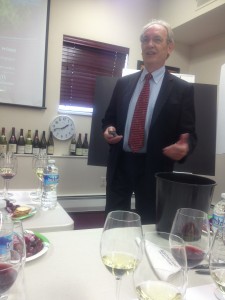 Add to this the complexity rule-wise of “climats” which loosely translates according to the speaker as the “DNA of the individual Bourgogne Vineyards” – I actually found a site in English that delves deeper into the climats concept – the “climats”. Climats equates closely with “terroir”..
Add to this the complexity rule-wise of “climats” which loosely translates according to the speaker as the “DNA of the individual Bourgogne Vineyards” – I actually found a site in English that delves deeper into the climats concept – the “climats”. Climats equates closely with “terroir”..
OK, now that you’re probably totally confused, let me say that much of what the speaker said rang true with what I had learned over the past 15 years at various wine classes and courses.
Burgundy has been producing serious wine since the Roman times, and afterwards the plots of land came from Church donations by nobles – they always gave their worst sites (poorest and rockiest soils) to the local Monasteries. Ironically, the rocky soils and hills they donated actually produce the world’s greatest wines!
The concept of “terroir” has really been developed from the wines of Burgundy more so than any other region – why?
1)They pretty much only use Pinot Noir for red wines and Chardonnay for white wines (a few exceptions like Aligote, but these are not blended)
2)hillside vineyards grow very different quality grapes from vineyards grown in the valley – hillier/higher sites produce more intense wine flavors, valley grapes are more generic.
3)Each vineyard site has it’s own weather patterns, geology, geography and even human/historical conditions. This last point is very confusing to most Americans: wine is made by humans, NOT by nature! Choosing the right site and propagating the best grapes is a human endeavor, but Nature is always adding chance to the equation. There is science as well as mysticism in the vineyard, maybe even some witchcraft..
“People can’t wait for aging wine any more, they want to drink everything young..”
A sad refrain by Jean-Pierre, but the reality of the modern wine drinker – people today don’t want to age their wines, so they want to drink young vintages before they’re ready to shine. There is so much history in Burgundy and even though winemaking today is better than ever, to truly understand and appreciate a fine age-worthy Burgundy, you simply must wait – Patience!
Cheers!
Charlie “I Drink on the Job” Adler
Upcoming French Events on TasteDC April/May 2013:
-April 30th – French Cooking: French Basics 101 at Cookology, $65
-May 1st – Wine Maker Dinner at Eola, featuring Château Léoville-Poyferré, $135
-May 20th – French Classics: The Suckling Pig, $60
Jancis Comes to the Smithsonian
From Jancis Robinson…”the thing I hate is limiting the mouthfuls”….of wine that is 😉
It was a fascinating evening of back and forth banter on Thursday, March 21st, 2013 when Jancis Robinson “performed” at the event “Jancis Robinson Toasts American Wines at the Smithsonian”
Dave McIntyre of both the Washington Post and his own Wine Line Blog interviewed and cajoled Jancis on a comfortable stage setting – the two seated in “comfy chairs” (OK – bad Monty Python reference! )
The discussion related to wine, specificially American, and Jancis’ latest book (with the fellow authorship of Linda Murphy) American Wine: The Ultimate Companion to the Wines and Wineries of the United StatesJancis has a very British speaking style and a dry wit that is best appreciated with a glass of wine. She mentioned that there are now 8,000 wineries in the US – the majority outside of California – and this is part of why America has become a great wine producing region on the international scene. I haven’t read the book, but she mentioned that it was primarily written by Linda Murphy who is a sports writer – and there is very little technical information about wine, the book was designed to be a fun read. I want to say – it is VERY difficult to make talking about wine interesting..Dave McIntyre did a very good job by broadening the topic from just American wine into lifestyle (mentions of wine tourism and also Dave’s own organization DrinkLocalWine ) as well as an interesting word association back-and-forth at the end: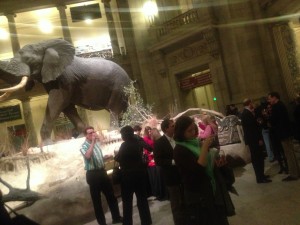
Overall, an excellent evening and the finish was a wine tasting in the famous Natural History Museum Auditorium with the elephant..nobody probably noticed, but the famous dinosaur Shark Jaws were hiding behind the wine exhibition..sort of like the evening – a subtle discussion of wine with amazingly delicious wines by American wineries from Idaho to Virginia – is America “biting back” at the French/Italian wine dominance of the past? Who knows – Cheers!Dave: “Natural Wines” ?
Jancis: “Very trendy right now..They have to be good!” (approximation of a quote!)
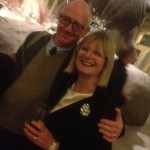
Charlie “I Drink on the Job” Adler
Wine Events Coming Up Over at TasteDC:
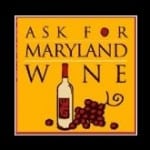 –DrinkLocalWine Conference, Saturday April 13th, Tremont Suites Hotel, Baltimore MD
–DrinkLocalWine Conference, Saturday April 13th, Tremont Suites Hotel, Baltimore MD
–Local Wines from Local Vines, Thursday April 25th – Anne Arundel Community College
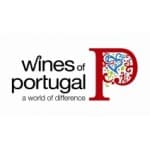 –Wines of Portugal 2013 Annual Grand Tasting (Special Discount..) National Tour comes to Washington, D.C., Thursday May 2nd, “W” Hotel Washington D.C.
–Wines of Portugal 2013 Annual Grand Tasting (Special Discount..) National Tour comes to Washington, D.C., Thursday May 2nd, “W” Hotel Washington D.C.
I Forgot to Spit! 80 Sips Comes to DC..
Professionals Spit Their Wines Out for a Reason..
How many times have I heard at a wine tasting – “why should I spit out or dump my wine out – I paid good money to attend this event?” Well, at a recent wine tour that came to DC Around the World in 80 Sips presented by Bottlenotes everyone behaved pretty orderly, but I had to recant tales to fellow wine lovers what the point of the spit bucket is – to prevent being bombed! What I always find entertaining about 100+ person walk-around wine tastings is how formal people are at the beginning of an event..maybe even a bit uptight..but how much they loosen up after the first hour or so.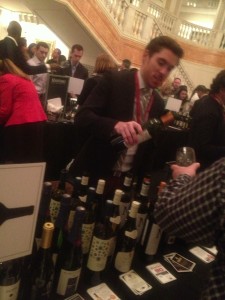 So Is There Proper Etiquette at a Wine Tasting?
So Is There Proper Etiquette at a Wine Tasting?
You know what they say about Americans – Anything Goes we take our democratic freedoms seriously, and we don’t like when people tell us to behave. Having said that, Americans often feel directionless when it comes to cultural events and particularly wine – what is the “proper” way to behave at a wine tasting? Believe it or not, I think many people are TOO polite at wine tastings, so here are some fun rules which you may feel FREE TO BREAK:
Rule #1: “Thou Shall Not Drink Everything In Thy Glass” The purpose of a spit bucket is 2-fold: first, so you can spit out wine so that you can drink more and not get drunk; second, so you can dump out excess wine for the same reason – not to get drunk! The wine professionals pouring the wine EXPECT you to dump out excess wine..they’re hoping you do so, they don’t want people to drink too much! Maybe it seems wasteful to Americans to throw away wine, but there’s a reason these are called “tastings”..dump away..
Rule #2: “Thou Shall Rinse Thy Glass Between Wines, But Not With Water” You rinse your wine glass so that the next wine tastes like the wine should. If you rinse your glass with water, that water will DILUTE the wine you’re about to taste..and it’s usually a pretty small pour. The way the PRO’s do it, is we ask for a little pour of the wine we are about to drink, we swirl and pour that excess into the bucket, and then we wait for the wine to be poured..in this way, the wine you’re tasting tastes like the..well, uhh..wine you’re tasting – not a blend of water/wine or wine and something else..I know, it seems like YOU’RE WASTING WINE..get over it..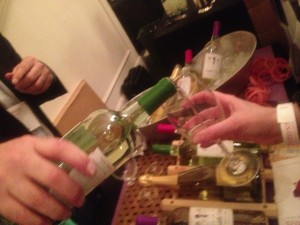
Rule #3:“Thou Shall Move Close to the Pourer and Put Thy Wine Glass Out To Receive a Pour” I actually have a funny story in my book I Drink on the Job about a woman who walked up to receive a pour of wine, but never put out her glass..she just stood in front of the table..thinking..about what, I have no idea, but when she was offered a pour of wine, she acted like it was an offense! Don’t use your time at a wine tasting to ruminate..you’re there to taste (NOT DRINK) wine..yes, of course take a few breaks, talk with your friends, get some food, etc..but use your time EFFICIENTLY. Walk up to the wine table and find a little space to stand, put out your wine glass (do not hold it close to your body..this is how you get wine on your clothing, and that’s a BAD THING!), and either wait for the wine to be poured or request a wine to be poured..this is NOT RUDE – this is actually proper..it’s efficient too..Personally, I’m a machine when I taste: stand, offer glass, swirl, look, sniff, taste, spit or swallow, spend moment in reflection on the wine, dump wine, REPEAT..
Rule #4: “Thou Shall Not Wear Perfume, Cologne or Anything That Has an Aroma at a Wine Tasting”I’m smelling coconuts in my wine..but, it’s not emanating from the glass – somebody wore a body lotion that smelled like coconuts! Actually, I spoke with her and she was very nice, but whenever she was within 5 feet of me..ALL I COULD SMELL WAS COCONUT LOTION!
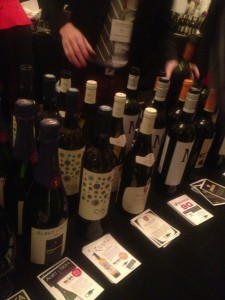
Hopefully, you take this post with good humor – none of the above mentioned Rules is really written in stone. We Americans love our independence and freedom, but when we try to behave at a cultural event, maybe we’re actually too polite..I’m not saying you should be a hillbilly and come into a wine tasting with a cavalier attitude, but it’s OK to loosen up, enjoy, and even have lively banter at a wine tasting. Within the confines of a wine tasting, there is room for self-expression, creativity, and of course conviviality, but it’s best to get the etiquette down pat first – Cheers!
Charlie “I Drink on the Job” Adler
Some Upcoming Wine Events on TasteDC:
– 4-Course Wine and Soul Wine Dinner, Tuesday, March 19th at The Fairfax Hotel at Embassy Row
– Cheese Class with Rogue Creamery’s Cheese Maker, Wednesday, March 27th, Ici Urban Bistro, 806 15th St., NW, Washington DC 20005
– Wines of Portugal 2013 Annual Grand Tasting (Special Discount..), Thursday, May 2nd, W Hotel Washington D.C. 515 15th St NW , Washington DC 20004
TEXXXAAAASS Wine Dinner at Mayfair & Pine
Everything is Bigger in Texas, but their wines are actually pretty subtle..
Andrew Stover of Vino 50 Selections presented some really great wines from his Texas portfolio at the TasteDC 6-Course Texas Wine Dinner at Mayfair & Pine on Saturday, March 2nd, 2013. Andrew is a well-known Sommelier and wine broker in the Washington, D.C. area who has a passion for American wines. My first question to Andrew prior to the event is how could Texas make great wines when the grapes have to suffer through such high heat and desert conditions. His reply was that hot dry weather is actually perfect for grapes – in fact, the dryness also prevents pests and allows the winemaker to actually make more natural/organic style wines. As far as we know, this was the first Texas wine dinner in the history of Washington, D.C. and thus an introduction of McPherson wines and Duchman Family wines to the dining public.
<Note: We have an Upcoming Anchor Beer Dinner on March 27th, 2013 at Mayfair and Pine>
The Dinner was my second at Mayfair and Pine, the first being the Champagne Dinner I attended in December at the restaurant. Chef Emily Sprissler is a Top Chef alum from Season 2 and she knows how to handle the heat! This event was held on a Saturday night which had the restaurant bustling both upstairs and downstairs – a real challenge for the chef.
Here’s the menu, the dishes and some comments about the dishes and wine pairings – Enjoy!
Duchman Family Vermentino
I really enjoyed this pairing – I’m not a big white wine fan, but the acidity of the wine cut through the citrus butter beautifully and actually made the dish much lighter to enjoy more food!
McPherson ‘Tre Colore’ Mourvedre/Carignan/Viognier Blend
Anything wrapped in bacon is great, and these little oysters were nicely nestled in this crunchy chewy porky goodness. This wine was a classic Rhone varietal blend and the slight earthiness of the Mourvedre and Carignan is nicely balanced by the fruit and acidyt of the Viognier – this just goes to show you that America can produce French style wines that are just as good if not better than the originals – American wine ingenuity!
4th Course
Halloumi Cheese & Radicchio Enchiladas
Duchman Family Sangiovese
Sangiovese is the grape of Chianti and so many spaghetti Italian dinners and it was a pleasant match in this wineries rendition. The slight spicyness of the sauce (almost like an Italian marinara) was tastefully offset by the roundness of the wine and created a nice marriage. Another fallacy is that traditional Mexican foods don’t go with wine (Cerveza!), but this again proved that wine is a great bedfellow with Mexican and authentic American cuisine.
5th Course
Wild Boar Swedish Meatballs
McPherson ‘La Herencia’ Tempranillo
These were some spicy meatballs! The Tempranillo grape is grown in the dry hot regions of Spain, so this wine really shined..Probably my favorite wine of the night..well, except someone brought a 1o year old McPherson Syrah that was really Super!
6th Course
Bacon Chocolate Pretzel S’mores
Coffee & Tea
It was overall a very nice meal and Texas wines will now be one of my Go-To staples – I’ve learned (over and over again!) that you should never assume with wine – just because you think a State is too hot, or cool, or whatever to produce wine, well then they’ll start producing wine, and you’ll be surprised. According to Andrew, Texas is the 6th largest producer of wine in the U.S. What other states are producing wine in the 7th to 50th positions? Who knows!?
Charlie “I Drink on the Job” Adler
Miner Family Wine Dinner Hits All the Right Spots..
Guest Post by Christina Portz “Just the Bottle”
Miner Family Winery Dinner – Tuesday, February 26th, 2013
Last night, I was lucky enough to attend the Miner Family Winery Dinner at 2100 Prime at the Fairfax Hotel as part of the Capital Wine Festival.
Because one can never have enough wine, I had a glass of Chandon in the Lounge before the event. There was an interesting assortment of characters in the lounge including a gentleman who used to frequent the restaurant when it was The Jockey Club and two conservative women arguing about Obama. My bartender had lived in DC since the 1980s and used to live on 17th street.
After I finished my glass, I checked in to the wine dinner. I found out I was seated at table 40 – with the winemaker. That’s how important I am (or that I like to think that). The restaurant has been renovated, but still maintains the old school/old DC decor. There was a lovely display set near a bar area of the wines featured for the evening.

Reception
2011 Miner Simpson Vineyard Viognier
For the reception the viognier was poured. It really is the perfect aperitif. It was incredibly aromatic with the honey suckle notes strongest on the finish.
The general manager spoke briefly, thanked everyone for attending and introduced Gary Brookman, Winemaker, Miner Family Winery.
Gary spoke briefly about the 2011 Miner Simpson Vineyard Viognier and presented the 2010 Miner, Napa Valley Chardonnay and 2008 Miner Wild Yeast, Napa Valley Chardonnay.
He provided background and history as to the winery, the use of solar panels at Miner and the incredible amount of varietals planted.
I was surprised at how Gary was down to Earth and incredibly pleasant. Besides speaking to the group at large, he frequently walked around to speak individually to the attendees.
First Course
Lobster Carpaccio
Mango and Avocado Salad, Coriander Cilantro Oil

The first course was paired with 2010 Chardonnay and 2008 Wild Yeast Chardonnay. The plating on this and all dishes was spectacular. The buttery notes in both wines went incredibly well with the lobster and avocado notes. There was a creaminess that as a person who normally hates avocado (yes I hate it and no, don’t try to change my mind) was incredibly harmonious.
I was excited to speak with Gary about these wines especially the wild yeast. Apparently, he likes using wild yeast and giving up that control.
He was quite entertaining explaining how wild yeast can start the fermentation and give up or burn out quickly. I imagined little yeasts partying too hard and then dying off as they made this amazing chardonnay.
The 2010 chardonnay did not spend any time in oak, but did go through some malolactic fermentation. The wild yeast had spicer notes on the finish and was more viscous.
Second Course
Red Wine Lacquered Quail
Arugula, Roasted Shallot Vinaigrette, Toasted Pinenuts

2010 Garys’ Vineyard Pinot Noir, Santa Lucia Highlands
Garys’ Vineyard is a 50 acre vineyard that was planted in 1995 by friends and growers Gary Franscioni and Gary Pisoni.
I love anything that incorporates an egg especially quail egg. The quail was perfectly cooked and seasoned. The pinot noir and quail worked well together bringing out additional flavors.
Gary and I discussed the concept of masculine and feminine pinot noirs. I used to have a boss who hated that description. Gary felt that this pinot was more masculine due to the body.
It was somewhat bright with big cherry notes on the nose with some plum on the finish.
Third Course
Pepper Crusted Virginia Bison
Wine Sauce, Horseradish Cauliflower Puree, French Beans

2009 Stagecoach Vineyard Cabernet Sauvignon
As you can see, I really wanted to try this amazing dish and forgot to take a photo before diving in (d’oh).
The 2009 Stagecoach Vineyard Cabernet Sauvignon is almost entirely made of cabernet sauvignon with about 5% cabernet franc and 5% merlot blended in. It was aged for 21 months in 60% new French oak. Definitely exhibits some of that almost toasty, vanilla notes on the nose.
The wine was silky with a lushness that went well with the pepper crusted Virginia bison. This was my favorite wine of the evening.
Fourth Course
Buttermilk Panna Cotta

Fresh Berries, Blood Orange Sabayon
2008 “the Oracle” Meritage Blend
The Oracle is a Meritage Blend utilizing Bordeaux style grapes (cabernet franc, cabernet sauvignon, malbec,merlot and petit verdot). It spends 21 months in 55% French oak. It was incredibly balanced and full bodied. There were hints of cassis and blackberries.
I was surprised (like others) that this wine was paired with the dessert. But, it totally worked! I think worked best with the top layer of the dessert – blood orange sabayon.
The Chef, Chef Ferrier, and some of his staff thanked us at the end of the night. They also answered questions regarding Virginia bison. I think some people were becoming more difficult and drunk as the night wore on.
In the end, this was an amazing experience with spectacular food, wine and service. I would highly recommend attending a future wine dinner at the Capital Wine Festival.
Editor’s Note: here are some upcoming Wine Dinners in the DC Area on TasteDC:
-6-Course Texas Wine Dinner on March 2nd (This Saturday Evening) $70, http://www.tastedc.com/event/6-course-texas-wine-dinner-mayfair-pine
-Patz and Hall Wine Dinner (March 5th), $125, http://tastedc.com/content/4-course-patz-hall-winery-wine-dinner
-Pio Cesare Wine Dinner (March 12th), $125, http://tastedc.com/content/4-course-pio-cesare-wine-dinner
-Wine and Soul Wine Dinner (March 19th), $135, http://tastedc.com/content/4-course-wine-and-soul-wine-dinner
-Tres Sabores Winery & Calder Wine Company Dinner (March 26th) $125, http://tastedc.com/content/4-course-tres-sabores-winery-calder-wine-company-wine-dinnerine Company Dinner (March 26th)
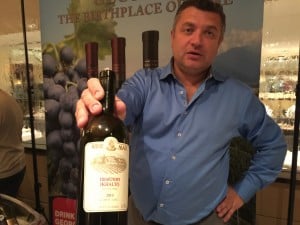
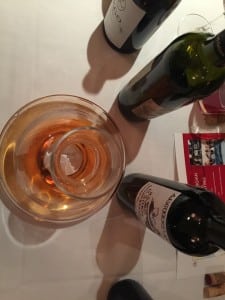
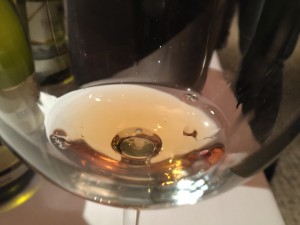
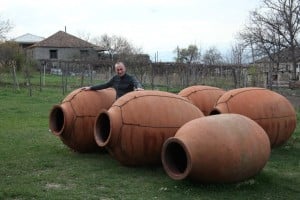

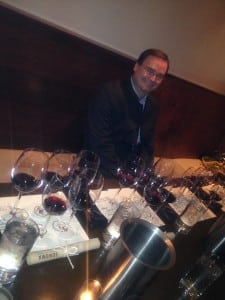
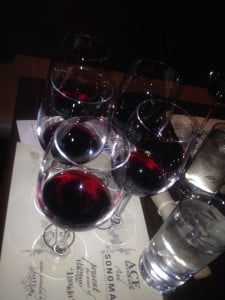
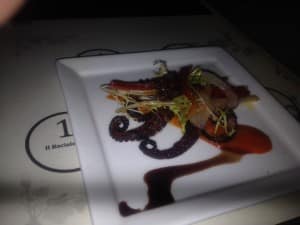
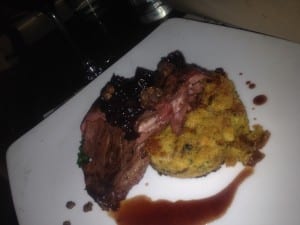
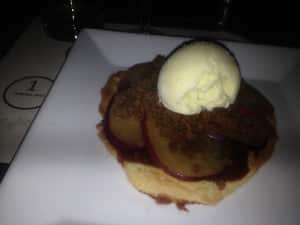
 Little known fact: the grape varietal “Barbera” was once a throw-away jug wine kind of grape that was never taken very seriously in the Piedmont Region of Italy where Barolo and Barbaresco are the King and Queen of wines respectively. Guiseppe Bologna, the founder of Braida winery, was the first back in the 1980’s to produce prodigious wines by planting Barbera vines on his family’s land and using new French oak as his aging barriques.
Little known fact: the grape varietal “Barbera” was once a throw-away jug wine kind of grape that was never taken very seriously in the Piedmont Region of Italy where Barolo and Barbaresco are the King and Queen of wines respectively. Guiseppe Bologna, the founder of Braida winery, was the first back in the 1980’s to produce prodigious wines by planting Barbera vines on his family’s land and using new French oak as his aging barriques.